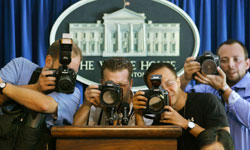Amid a sense of increasing White House control over press coverage, the White House Correspondents’ Association has had enough.
“It’s time for us to band together behind a comprehensive set of principles and practices we believe should be followed at the White House,” Christi Parsons, this year’s association president, wrote Wednesday to members in unveiling draft principles and requests for greater access.
The proposals made to the association members include the president taking questions from the press “on a regular basis, no less than once per week” and being “available in response to significant news developments.”
It also requests that he holds “full press conferences at least once a month and takes questions frequently from the pool.”
In addition, it asks that he “allow the pool to witness and record him or her at work on a regular basis. “
“Many of you have helped us draft a working version of such a thing over the last nine months, whether you’ve been interviewed by a board member, taken part in a working group or emailed your thoughts to one of us,” wrote the White House correspondent for Tribune Co. (and a former colleague of mine at the Chicago Tribune).
“The board updated these documents based on their recommendations, and we now submit them to all of you for your consideration,” wrote Parsons, who will oversee the group’s celebrity-filled annual gala dinner on Saturday.
The internal discussions confront growing frustrations over Obama administration restrictions on access to the president and other officials, including seldom holding press conferences. It’s the continuation of a trend among recent presidents and is partly driven by every White House’s assumptions, which can often prove erroneous, that it can control its “message” on various matters.
And, almost inevitably, when things go wrong, and a president’s approval ratings decline, there is finger pointing at the press as somehow partly to blame.
No surprise, for several years there’s been a sense among some in the West Wing that Obama’s achievements have not been given sufficient note and a belief that lesser matters at times convulse the press corps.
Thus, what might actually be justified popular unease with policies can often be viewed within the hothouse of the White House as the fault of the media, and thus the public, not properly understanding the president’s aims and actions.
The narrowing access prompting the press response also includes Obama officials circumventing the mainstream media by distributing “news” via the White House’s own own social media and using many newer, non-traditional outlets.
There’s also the issue of images. The subject has prompted tensions between journalists and chief White House photographer Pete Souza (another former colleague of mine) over what reporters and photographers argue is growing White House control over and distribution of pictures of the president.
Parsons passed along to members a draft of both a declaration of principles and one of prospective practices, asking for responses.
Here’s the full email from the White House Correspondents’ Association followed by the two draft resolutions:






